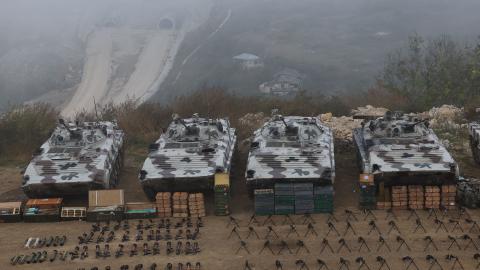This has been a historic week in the South Caucasus. For Azerbaijan and Armenia, one chapter in a long and often deadly story has ended. Now both sides must look toward the future.
After intense fighting in the region in the early 1990s, Armenia ended up occupying a sizable area of Azerbaijan, including the Karabakh region, for almost three decades. During this period, Yerevan propped up a separatist government, the so-called “Republic of Artsakh,” led by ethnic Armenians and not recognized by any other country in the world.
During the 2020 Karabakh War, Azerbaijan regained control of most of its territory. The resulting ceasefire agreement left a small section of Karabakh out of the hands of Baku and under the supervision of a Russian peacekeeping force.
On Sept. 19 this year, Azerbaijan launched a military operation to retake the remaining parts of Karabakh. The Russian peacekeepers on the ground sat idly by and did nothing. In less than 24 hours, a ceasefire was agreed and the Armenian forces, and Armenian-backed separatists, laid down their weapons.
For international observers of the South Caucasus, what has happened in the past few weeks in Karabakh should not have come as a surprise. There are a few factors that led to the recent events. Firstly, there is a perception that Russia is weak in the region right now as a result of its quagmire in Ukraine. Azerbaijan was never happy with the presence of Russian troops on its territory in the aftermath of the 2020 Karabakh War, and Baku has been looking for the right time to make a move that might lead to their departure from the region.
Secondly, “presidential elections” for the so-called “Republic of Artsakh” were held by the Armenian separatists in Karabakh this month. Unsurprisingly, Azerbaijan considered these elections to be illegal and needlessly provocative. They were not alone in this. There were also strong statements of condemnation from the Council of Europe, the EU, the Organization of Islamic Cooperation, and the Organization of Turkic States.
Thirdly, there was the issue of transit links. For countries such as Azerbaijan located in the heart of Eurasia, transport connections to the outside world are key. As part of the agreement that ended the 2020 war, Azerbaijan committed itself to building a new road connecting Armenia with the section of Karabakh under the control of the Russian peacekeepers.
This was accomplished in 2022, a year earlier than was required by the 2020 ceasefire agreement. In return, Armenia pledged to “guarantee the security of transport connections” between Azerbaijan proper and its autonomous Nakhchivan exclave, through Armenia’s Syunik province. This has yet to happen. Understandably, the lack of progress on this promise has frustrated Baku.
Finally, and perhaps most importantly, what the world saw play out in Karabakh over the past couple of weeks was the culmination of more than three decades of diplomatic failures. Since the early 1990s, four UN Security Council resolutions were passed calling for the “cessation of all hostilities and the immediate, complete and unconditional withdrawal of the occupying forces” from Azerbaijan. None were ever enforced.
The war in 2020 should have served as a wake-up call for the international community to redouble its efforts to find a long-lasting and durable peace between Armenia and Azerbaijan, but all efforts failed.
















